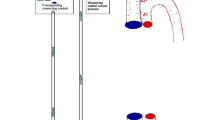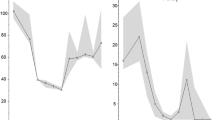Summary
An experimental model was used to investigate acute alterations of cerebral metabolic activity in rats subjected to subarachnoid haemorrhage (SAH). Haemorrhages were produced in anaesthetized animals by injecting 0.3 ml of autologous, arterial nonheparinized blood into the cisterna magna. Control rats received subarachnoid injections of mock-cerebrospinal fluid to study the effect of sudden raised intracranial pressure, or underwent sham operation. Three hours after SAH rats were given an intravenous injection of [14C]-2-deoxyglucose. Experiments were terminated by decapitation, and the brains were removed and frozen. Regional brain metabolic activity was studied by quantitative autoradiography. In comparison with sham-operated controls, cerebral metabolic activity was diffusely decreased after SAH. Statistically significant decreases in metabolic rate were observed in 23 of 27 brain regions studied. Subarachnoid injections of mock-cerebrospinal fluid also produced depression of cerebral metabolic activity, but quantitatively these changes were not as pronounced and diffuse as in SAH rats. The present study shows that a widespread depression of brain metabolism occurs in the acute stage after experimental SAH and is probably secondary to the Subarachnoid presence of blood itself and/or blood products.
Similar content being viewed by others
References
Bederson JB, Germano IM, Guarino L (1995) Cortical blood flow and cerebral perfusion pressure in a new noncraniotomy model of subarachnoid hemorrhage in the rat. Stroke 26: 1086–1092
Carpenter DA, Grubb RL, Tempel LW, Powers W (1991) Cerebral oxygen metabolism after aneurysmal subarachnoid hemorrhage. J Cereb Blood Flow Metab 11: 837–844
d'Avella D, Germanò A, Santoro G,et al (1990) Effect of experimental subarachnoid hemorrhage on CSF eicosanoids in the rat. J Neurotrauma 7: 121–129
d'Avella D, Zuccarello M, Tomasello F (1993) Protective effect of U78157G on local cerebral glucose utilization in the acute stage following subarachnoid hemorrhage (SAH). In: Findlay JM (ed) Cerebral vasospasm. Elsevier, Amsterdam, pp 427–430
d'Avella D, Cicciarello R, Gagliardi ME,et al (1994) Progressive perturbations in cerebral energy metabolism after experimental whole-brain radiation in the therapeutic range. J Neurosurg 81: 774–779
d'Avella D, Germano A, Tomasello F (1994) Early blood-brain barrier changes after experimental subarachnoid haemorrhage: a quantitative and electron microscopy study. In: Pasqualin A, Da Pian R (eds) New trends in management of cerebro-vascular malformations. Springer, Wien New York, pp 48–51
Delgado TJ, Arbab MAR, Diemer NH, Svendgaard NA (1986) Subarachnoid hemorrhage in the rat: cerebral blood flow and glucose metabolism during the late phase of cerebral vasospasm. J Cereb Blood Flow Metab 6: 590–599
Delgado TJ, Diemer NH, Svendgaard NA (1986) Subarachnoid hemorrhage in the rat: cerebral blood flow and glucose metabolism after selective lesions of the catecholamine systems in the brainstem. J Cereb Blood Flow Metab 6: 600–606
Doczi T (1985) The pathogenetic and prognostic significance of blood-brain barrier damage at the acute stage of aneurysmal subarachnoid haemorrhage. Clinical and experimental studies. Acta Neurochir (Wien) 77: 110–132
Dorsch NW, Branston NM, Symon L (1989) Intracranial pressure changes following primate subarachnoid hemorrhage. Neurol Res 11: 201–204
Faraci FM (1993) Endothelium-derived vasoactive factors and regulation of the cerebral circulation. Neurosurgery 33: 648–658
Fein JF (1975) Cerebral energy metabolism after subarachnoid hemorrhage. Stroke 6: 1–8
Fein JF (1976) Brain energetics and circulatory control after subarachnoid hemorrhage. J Neurosurg 45: 498–507
Germanò A, d'Avella D, Cicciarello Ret al (1992) Blood-brain barrier permeability changes after experimental subarachnoid hemorrhage. Neurosurgery 30: 882–886
Germanò A, Dixon CE, d'Avella D,et al (1994) Behavioral deficits following experimental subarachnoid hemorrhage in the rat. J Neurotrauma 11: 345–353
Goochee C, Rasband W, Sokoloff L (1980) Computerized densitometry and color coding of (14C) deoxyglucose autoradiography. Ann Neurol 7: 359–370
Grubb RL, Raichle ME, Eichung JO, Gado MH (1977) Effects of subarachnoid hemorrhage on cerebral blood volume, blood flow and oxygen utilization in humans. J Neurosurg 46: 446–453
Haley EC, Kassell NF, Torner JC,et al (1993) A randomized controlled trial of high-dose intravenous nicardipine in aneurysmal subarachnoid hemorrhage. A report of the Cooperative Aneurysm Study. J Neurosurg 78: 537–547
Haley EC Jr., Kassell NE, Wayne MA,et al (1995) Phase II trial of tirilazad in aneurysmal subarachnoid hemorrhage. A report of the Cooperative Aneurysm Study. J Neurosurg 82: 786–790
Hall ED, Travis MA (1988) Effect of nonglucocoticoid 21-aminosteroid U74006F on acute cerebral hypoperfusion following experimental subarachnoid hemorrhage. Exper Neurol 102: 244–248
Hauerberg J, Juhler M (1994) Cerebral blood flow autoregulation in acute intracranial hypertension. J Cereb Blood Flow Metab 14: 519–525
Hauerberg J, Rasmussen G, Juhler M, Gjerris F (1995) The effect of nimodipine on autoregulation of cerebral blood flow after subarachnoid hemorrhage in rat. Acta Neurochir (Wien) 132: 98–103
Iwanaga H, Okuchi K, Koshimae N, Goda K, Imanishi M, Tokunaga H, Aoki H, Boku E, Sakaki T (1995) Effects of intravenous nitroglycerine combined with dopamine on intracranial pressure and cerebral arteriovenous oxygen difference in patients with acute subarachnoid haemorrhage. Acta Neurochir (Wien) 136: 175–180
Jackowski A, Crockard A, Burnstock G, Lincoln J (1989) Alterations in serotonin and neuropeptide Y content of cerebrovascular sympathetic nerves following experimental subarachnoid hemorrhage. J Cereb Blood Flow Metab 9: 271–279
Jackowski A, Crockard A, Burnstock G,et al (1990) The time course of intracranial pathophysiological changes following experimental subarachnoid hemorrhage in the rat. J Cereb Blood Flow Metab 10: 835–849
Jakobsen M, Enevoldsen E, Bjerre P (1990) Cerebral blood flow and metabolism following subarachnoid hemorrhage: cerebral oxygen uptake and global blood flow during the acute period in patients with SAH. Acta Neurol Scand 82: 174–182
Jakobsen M, Skjodt T, Enevoldsen E (1991) Cerebral blood flow and metabolism following subarachnoid hemorrhage: effect of subarachnoid blood. Acta Neurol Scand 83: 226–233
Jakubowski J, Bell BA, Symon L,et al (1982) A primate model of subarachnoid hemorrhage: changes in regional cerebral blood flow, autoregulation, carbon dioxide reactivity, and central conduction time. Stroke 13: 601–611
Kamiya K, Kujama H, Syman L (1983) An experimental study of the acute stage of subarachnoid hemorrhage. J Neurosurg 59: 917–924
Marzatico F, Gaetani P, Rodriguez Y, Baena R,et al (1988) Bioenergetics of different brain areas after experimental subarachnoid hemorrhage in rats. Stroke 19: 378–384
McCormick PW, McCormick J, Zabramski JM,et al (1994) Hemodynamics of subarachnoid hemorrhage arrest. J Neurosurg 80: 710–715
Meyer CHA, Lowe D, Meyer M,et al (1983) Progressive change in cerebral blood flow during the first three weeks after subarachnoid haemorrhage. Neurosurgery 12: 58–76
Mickey B, Vorstrup S, Voldby B,et al (1984) Serial measurement of regional cerebral blood flow in patients with SAH using133Xe inhalation and emission computerized tomography. J Neurosurg 60: 916–922
Öhman J, Servo A, Heiskanen O (1991) Long-term effects of nimodipine on cerebral infarcts and outcome after aneurysmal subarachnoid hemorrhage and surgery. J Neurosurg 74: 8–13
Paxinos G, Watson C (1982) The brain in stereotaxic coordinates. Academic Press, New York
Rasmussen G, Hauerberg J, Waldemar G,et al (1992) Cerebral blood flow autoregulation in experimental subarachnoid hemorrhage in rat. Acta Neurochir (Wien) 119: 128–133
Sakaki S, Ohta S, Nakamura H, Takeda S (1988) Free radical reaction and biological defense mechanism in the pathogenesis of prolonged vasospasm in experimental subarachnoid hemorrhage. J Cereb Blood Flow Metab 8: 1–8
Sasaki T, Kassell NF, Yamashita M,et al (1985) Barrier disruption in the major cerebral arteries following experimental subarachnoid hemorrhage. J Neurosurg 63: 433–440
Schneider GH, v Helden A, Lanksh WR, Unterberg A (1995) Continuous monitoring of jugular bulb oxygen saturation in comatose patients. Therapeutic implications. Acta Neurochir (Wien) 134: 71–75
Seifert V, Löffler BM, Zimmermann M,et al (1995) Endothelin concentrations in patients with aneurysmal subarachnoid hemorrhage. Correlation with cerebral vasospasm, delayed ischemic neurological deficits, and volume of hematoma. J Neurosurg 82: 55–62
Sokoloff L, Reivich M, Kennedy C,et al (1977) The [14C]-deoxyglucose method for the measurement of local cerebral glucose utilization: theory, procedure, and normal values in the conscious and anesthetized albino rat. J Neurochem 28: 897–916
Solomon RA, Lobo Antunes J, Chen RYZ,et al (1985) Decrease in cerebral blood flow in rats after experimental subarachnoid hemorrhage: a new model. Stroke 16: 58–64
Solomon RA, Lovitz RL, Hegemann MT,et al (1987) Regional cerebral metabolic activity in the rat following experimental subarachnoid hemorrhage. J Cereb Blood Flow Metab 7: 193–198
Talacchi A (1993) Sequential measurements of cerebral blood flow in the acute phase of subarachnoid hemorrhage. J Neurosurg Sci 37: 9–18
Tildon JT, Stevenson JH (1984) Decreased oxidation of labeled glucose by dissociated brain cells in the presence of fetal bovine serum. Science 224: 903–904
Tildon JT, Stevenson JH, Roeder LM (1987) Serum effects on substrate oxidation by dissociated brain cells: possible sites of action. Brain Res 403: 127–135
Travis MA, Hall ED (1987) The effects of chronic two-fold dietary vitamin E supplementation on subarachnoid hemorrhage-induced brain hypoperfusion. Brain Res 418: 366–370
Umanski F, Kaspi T, Shalit M (1983) Regional cerebral blood flow in the acute stage of experimentally induced subarachnoid hemorrhage. J Neurosurg 58: 210–216
Voldby B, Enevoldsen EM, Jensen FT (1985) Regional CBF, intraventricular pressure, and cerebral metabolism in patients with ruptured intracranial aneurysms. J Neurosurg 62: 48–58
Zuccarello M, Andersen DK (1989) Protective effect of a 21-aminosteroid on the blood-brain barrier following subarachnoid hemorrhage in rats. Stroke 20: 367–371
Author information
Authors and Affiliations
Rights and permissions
About this article
Cite this article
d'Avella, D., Cicciarello, R., Zuccarello, M. et al. Brain energy metabolism in the acute stage of experimental subarachnoid haemorrhage: Local changes in cerebral glucose utilization. Acta neurochir 138, 737–744 (1996). https://doi.org/10.1007/BF01411481
Issue Date:
DOI: https://doi.org/10.1007/BF01411481




